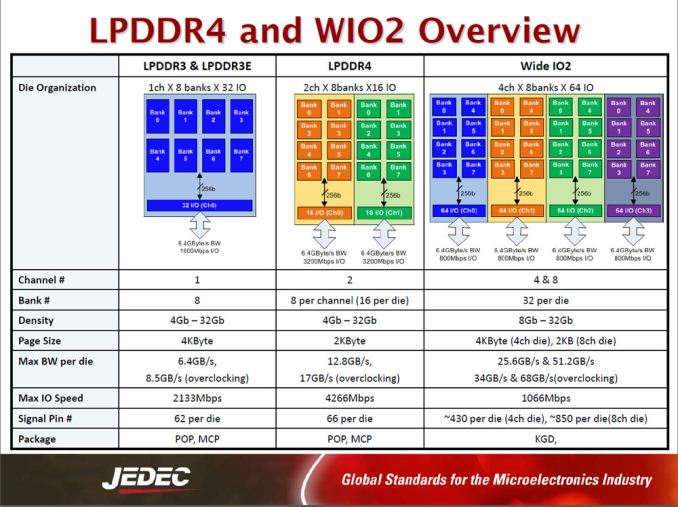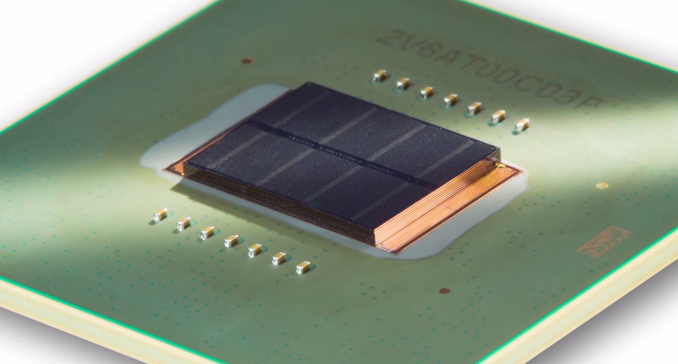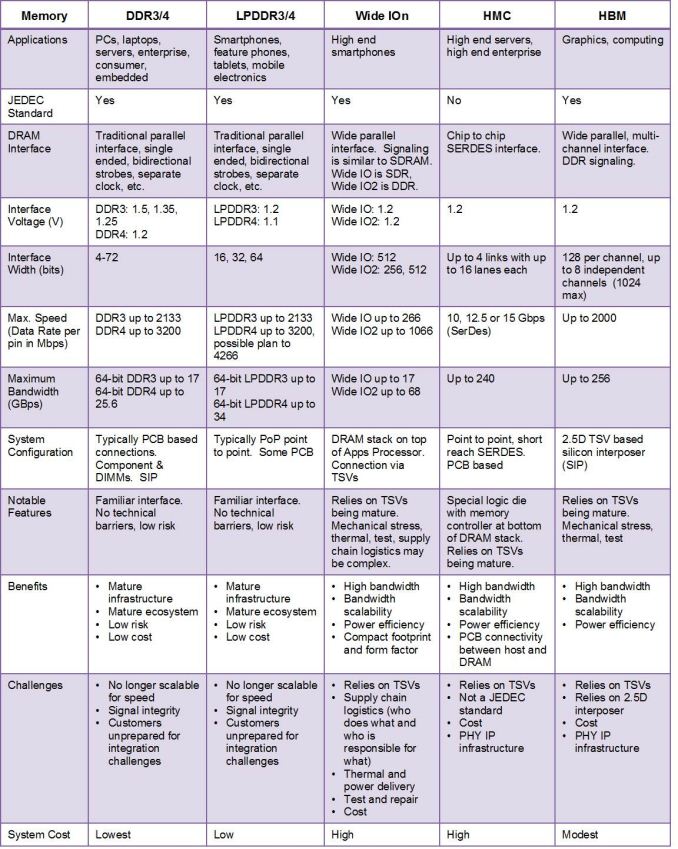DDR4 Haswell-E Scaling Review: 2133 to 3200 with G.Skill, Corsair, ADATA and Crucial
by Ian Cutress on February 5, 2015 10:10 AM ESTThe Future of DDR4
DDR4 was first launch in the enthusiast space for several reasons. On the server side, any opportunity to use lower power and drive cooling costs down is a positive, so aiming at Xeons and high-end consumer platforms was priority number one. Any of the big players in the datacenter space most likely had hardware in and running for several months before the consumer arms got hold of it. Being such a new element in the twisting dynamic of memory, the modules command a premium and the big purchasers got first pick. The downside of when that shifts to consumer where budgets are tighter and some of the intended benefits of DDR4 are not that important, such as lower power, it causes problems. When we first launched our Haswell-E piece, the cost of a 4x4GB kit of JEDEC DRAM for even a basic eight-core system was over $250, and not much has changed since. Memory companies have lower stock levels, driving up the cost, and will only make and sell more if people start buying them. At this point, Haswell-E and DDR4 is really restricted to early adopters or those with a professional requirement to go down this route.
DDR4 will start to get interesting when we see it in the mainstream consumer level. This means when regular Core i3/i5 desktops come into being, and eventually SO-DIMM variants in notebooks. The big question, as always, is when. If you believe the leaks, all arrows point towards a launch with Skylake on the Intel side, after Broadwell. Most analysts are also in this category, with the question being on how long the Broadwell platform on desktops is to last. The 14nm process node had plenty of issues, meaning that Q1 2015 is when we have started to see more Core-M (Broadwell-Y) products in notebooks and the launch of Broadwell-U, aiming at the AIO and mini-PC (such as the NUC and BRIX) market as well as laptops. This staggered launch would suggest that Broadwell on desktops should be due in the next few months, but there is no official indication as to when Skylake will hit the market, and in what form first. As always, Intel does not comment on unreleased product when asked.
On the AMD side of the equation, despite talks of a Kaveri refresh popping up in our forums and discussions about Carrizo focusing only on the sub-45W market with Excavator cores, we look to the talk surrounding Zen, K12 and everything that points to AMD’s architecture refresh with Jim Keller at the helm sometime around 2016. In a recent round table talk, Jim Keller described Zen as scaling from tablet to desktop but also probing servers. One would hope (as well as predict and imagine) that AMD is aiming for DDR4 with the platform. It makes sense to approach the memory subsystem of the new architecture from this angle, although for any official confirmation we might have to wait a few months at the earliest when AMD start releasing more information.
When DDR4 comes to desktop we will start to see a shift in the proportions of the market share that both DDR4 and DDR3 will get. The bulk memory market for desktop designs and mini-PCs will be a key demographic which will shift more to an equal DDR3-DDR4 stage and we can hope to achieve price parity before then. If we are to see mainstream DDR4 adoption, the bulk markets have to be interested in the performance of the platforms that require DDR4 specifically but also remain price competitive. It essentially means that companies like G.Skill that rely on DRAM sales for the bulk of their revenue have to make predictions on the performance of platforms like Skylake in order to tell their investors how quick DDR4 will take the market. It could be the difference between 10% and 33% adoption by the end of 2015.
One of the questions that sometimes appears with DDR4 is ‘what about DDR5?’. It looks like there are no plans to consider a DDR5 version ever for a number of reasons.
Firstly, but perhaps minor, is the nature of the DRAM interface. It relies on a parallel connection and if other standards are indicative of direction, it should probably be upgraded to a serial connection, similarly as how PCI/PCI Express and PATA/SATA has evolved in order to increase throughput while at the same time decreasing pin counts and being easier to design for the same bandwidth.
Secondly, and more importantly, are the other memory standards currently being explored in the research labs. Rather than attempt to copy verbatim a piece from ExtremeTech, I’ll summarize it here. The three standards of interest, whilst mostly mobile focused, are:
Wide I/O 2: Designed to be placed on top of processors directly, abusing a larger number of I/O pins by TSVs, keeping frequencies down in order to reduce heat generation. This has benefits in industries where space is at a premium, saving some PCB area in exchange for processor Z-height.
Hybrid Memory Cube (HMC): Similar to current monolithic DRAM dies but using a stacked slice over a logic base, allowing for much higher density and much higher bandwidth within a single module. This also increases energy efficiency, but introduces higher cost and requires higher power consumption per module.
High Bandwidth Memory (HBM): This is almost a combination of the two above, specifically aimed more at graphics by offering multiple DRAM dies stacked on or near the memory controller to increase density and bandwidth. It is more described as a specialized implementation of Wide I/O 2, but should afford up to a 256GB/s bandwidth on a 128-bit bus with 4-8 stacks on a single interface.
Image from ExtremeTech
Moving some of the memory power consumption onto the processor directly has thermal issues to consider, which means that memory bandwidth/cost might be improved at the expense of operating frequencies. Adding packages onto the processor also introduces a heavy element of cost, which might leave these specialist technologies to the super-early adopters to begin with.
Given the time from DDR4 being considered to it actually entering the desktop market, we can safely say that DDR4 will become the standard memory option over the next four years, just as DDR3 is right now. Beyond DDR4 is harder to predict, and depends on how Intel/AMD want to approach a solution that offers higher memory bandwidth, depending at what cost. Both companies will be looking at how their integrated graphics are performing, as that will ultimately be the best beneficiary to the design. AMD has some leverage in the discrete GPU space and will be able to transfer any knowledge used over to the CPU side, but Intel has a big wallet. Both Intel and AMD has experimented with eDRAM/SRAM as extra level caches with Crystal Well and PS4/XBone, which puts less stress on the external memory demands when it comes to processor graphics, which leads me to the prediction that DDR4 will be here in the market longer than DDR3 or DDR2.
If any of the major CPU/SoC manufacturers want to invest heavily in Wide I/O 2, HBM or HMC, we will have to wait. If it changes what we see on the desktop, the mini-PC or the laptop, we might have to wait even longer.













120 Comments
View All Comments
wyewye - Sunday, February 8, 2015 - link
Extremely weak review.Ian, is this your first memory review?
Everyone knows in the real world apps the difference is small. Whats the point to show a gazilion of charts with 1% differences. You had way more random noise from the tests errors, those numbers are meaningless.
For memory, the syntetic tests is the only way.
Thumbs down, bring back Anand for decent reviews.
wyewye - Sunday, February 8, 2015 - link
@IanProTip: when the differences are small and you get obviously wrong results like 2800@cl14 slower than 2133@cl16, run 10 or 20 tests, eliminate spikes and compute the median.
wyewye - Sunday, February 8, 2015 - link
Ian stop being sloppy and do a better job next time!Oxford Guy - Sunday, February 8, 2015 - link
"Moving from a standard DDR3-2133 C11 kit to DDR4-2133 C15, just by looking at the numbers, feels like a downgrade despite what the rest of the system is."Sure... let's just ignore the C10 and C9 DDR3 that's available to make DDR4 look better?
eanazag - Monday, February 9, 2015 - link
Why not post some RAM disk numbers?What I saw in the article is that the cheapest, high capacity made the most sense for my dollar.
SFP1977 - Tuesday, February 10, 2015 - link
Am I missing something, or how did they over come the fact that their 2011 test processor has 4 memory lanes while that 1150 processor has only 2??deanp0219 - Wednesday, February 11, 2015 - link
Great article, but in fairness, you're comparing the first run of DDR4 modules against very well developed and evolved DDR3 modules. When DDR3 was first released, I'll bet some of the high-end DDR2 modules available at the time matched up with them fairly well. We'll have to see where DDR4 technology goes from here. Again, great read though. Totally not a reflection on the article -- nothing you can do about the state of the tech. Made me feel better about my DDR3-2133 machine!MattMe - Friday, July 10, 2015 - link
Am I right in thinking that the benefits of DDR4 outside of power consumption could well be in scenarios where integrated graphics are being utilised?The additional channels and clock speeds are more likely to have an effect there than an external GPU, I would assume. But we're still yet to see any DDR4L in the consumer market (as far as I'm aware), it's most beneficial area.
Seeing some benchmarks including integrated graphics would be very interesting, especially in smaller, lower powered systems like a NUC or similar.
LorneK - Monday, October 5, 2015 - link
My gripe with Cinebench as a "professional" test is that aside from tracing rays, it in no way resembles the kind of rendering that an actual professional would be doing.There's hardly any geometry, hardly any textures, no displacement, no advanced lighting models, etc.
So yeah, DDR4 makes barely any impact in Cinebench, but I have to wonder how much of that is due to Cinebench requiring almost nothing from RAM in general.
Someone needs to come along and make a truly useful rendering benchmark. A complex scene with millions of polygons, gigs of textures, global illumination, glossy reflections, the works basically.
Only then can we actually know what various aspects of a machine's hardware are affecting.
An amazing SSD would reduce initial scene spool up time. Fast single thread performance would also increase render start times. Beefy RAM configs would be better at feeding the CPUs the multiple GBs needed to do the job. And the render tiles would take long enough to complete that a 72 thread Xeon box isn't wasting half its resources simply moving from tile to tile and rendering microscopic regions.
Zerung - Tuesday, February 9, 2016 - link
My Asus Mobo notes the following:'Due to Intel® chipset limitation, DDR4 2133 MHz and higher memory modules on XMP mode will run at the maximum transfer rate of DDR4 2133 Mhz'. Does this mean that running the DDR4 3400 CL16 may not give me the latency below 10?
Thanks